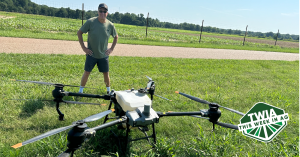By Heather Jennings, PE

Sometimes it’s an easy problem, and what I mean by “easy” is that it is an easily identifiable problem such as equipment failure–a pump or aerator having gone out that you have to wait to have rebuilt. It could also be waiting for a part to come in to get your system up and running.
When it’s not one of those kinds of easy problems, we will have to dig deeper. Let’s start with the basics that apply to any type of system. Check your flow meters. Have your flows ramped up significantly due to seasonal rainfall or snow melt? Have new customers come online that have more impact than originally anticipated, such as restaurants or commercial users? Now you’ve evaluated your flows, and found that’s not the problem.
Let’s look at your data. I encourage all plant operators to trend their data, either with Microsoft Excel or a SCADA system, or even on paper. What you will be looking for is to determine if your BOD:Nitrogen:Phosphorus data come in around 100:5:1. If your system runs a little higher or lower in general, that’s okay, as 100:5:1 is best used as a rule of thumb. If your BOD has increased dramatically, but your nitrogen and phosphorus haven’t, your bugs (microorganisms) could be starving for macronutrients. Or your system might have too much nitrogen and phosphorus for the BOD you currently have coming in.
I also like to compare TKN to BOD. You want to be between 0.1 to 0.2 for typical operation. If you don’t have that data, grab a sample and send it out to a lab or use an infield kit for quick answers. So, with a BOD of 250 mg/L, you should have a TKN of 25 mg/L to 50 mg/L for typical domestic wastewater.
If your issues are with nitrification, do a system audit. The easiest way to do that is to compare speciated nitrogen from your influent with the speciated effluent of your aeration basin and clarifiers. This is possible for a multi-lagoon system as well. Capture grab samples from the effluent out of each pond to see the percentage reduction of nitrogen in each pond. It can give you a better idea of where to put your aeration, as well.
How about your BOD/COD ratio? For typical domestic wastewater plants, the ratio is between 0.3 to 0.8. Has that ratio recently changed in your system? It’s important to realize that influent BOD/COD ratios greater than 0.5 are easily treated in biological systems. If your ratio drops closer to 0.3 or even lower, you’ll know you’ve been hit by a significant chemical toxicity. If this happens, you will need to consider increasing your wasting to remove the toxicity in the system, then concentrate on reestablishing your microbial population either through time or bio-augmentation. (Call us, we can help with that!) Recirculating dead biomass or toxicity doesn’t help your system recover any faster and can even prolong the issue.
One more thing: Are you looking at your microbes weekly? It’s pretty rare that operators of a small system have the ability and/or the time to look at their biomass, but it is a great tool or indicator of issues in the system. Afraid you won’t know what you’re looking at? Then order one of the microbe posters from WEF and just start looking. Even if you don’t understand what you’re looking at, you will start to get a feel for what is around in your system when operations are stable. Then when things change in your system, you will see it. As a side note, you’ll easily be able to see if your biomass is dead as the microbes will be dead. You’ll also be able to review your floc and identify any upcoming filamentous issues cropping up.
System upsets will never go away completely but, hopefully—with a few more tools, data points, and microbial scans—you will be able to overcome them sooner rather than later!
Related Posts

This Week in Ag #74
Look up in the sky: it’s a bird, it’s a plane, it’s… a drone? This weekend I flyover fed my corn using a Rantizo drone. My corn has well exceeded the height of the ground rig, and airplane application is not an option. Since I wanted to feed and protect the crop at its present R3...

This Week in Ag #22
Twenty years ago, I found myself in the position of operating a farm all by myself. My father, who I was farming with, passed away suddenly that January. So in addition to my full-time ag marketing job, I was flying solo across my family farm in western Illinois.

The Right Stuff for Soils and Plants
By Mojtaba Zaifnejad, PhD When applied fertilizers benefit soil health and plant growth, and are readily available to them, it is said that they are bioavailable. The extent of bioavailability of nutrients and fertilizers applied to soil and plants determines their effectiveness in improving soil health and crop yield. In addition to the 4Rs approach,...

